Recent Developments and Trends
|

Virtual Pet Design & Consulting Services |
Recent Developments and Trends
|

Virtual Pet Design & Consulting Services |
Written 18 September 1997 Last Major Update 31 Oct 1997 This two part article is very heavy with graphics. Each part will take a while to load.Through my involvement in the Virtual Pet Homepage I have seen hundreds of keychain virtual pets in recent months. New developments in one pet are rapidly copied by others. Some pets have several new features, others are basically clones of existing pets. Many enthusiasts are no longer captivated by the basic 3 button, egg shaped dog, cat, dinosaur pets. In an effort to gain more business (sell more pets to existing customers and sell pets to new customers) manufacturers have added new features to their pets. Some of these features are very successful and are rapidly copied by others. New features that are not successful for whatever reason (not liked, fail to work, break, cost too much) may result in a pet being withdrawn from the market, or even in the failure of a company.
I have attempted to list the trends sequentially in the order in which they occurred. Some were simultaneous and overlapping, but the order still gives a general historic account of the rapid developments in keychain virtual pets from late 1996 to the present (November 1997).
It is a symptom of how fast this industry is moving that I apologize for the datedness of this article even as it is being written. Things are moving so fast that while this article captures the trends of the industry today, we expect to see new trends tomorrow. If this article is well received, I will try to update it as trends change and time permits. Please let us know what you think of this article by clicking on the mail box at the bottom of the page.
I would also like to add a special thanks to Robert Worne for his assistance with this article.
Bandai's Tamagotchi took Japan by storm in late 1996 and the rest of the world in 1997.
Even with proven suppliers, a large distribution system, and sound financial backing, Bandai was unable able to meet the demand for Tamagotchi as the world caught "Tamagotchi Fever". Everywhere you went, there were sold out signs. Stores announced when their next orders would be received and long lines formed waiting for the pets. Some feel Bandai may have taken on the U.S. and European market before meeting all the demand in Japan in order to keep the excitement and media going in Japan.
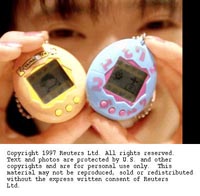
 |
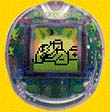 |
GigaPet |
GigaPet |
This rapid proliferation of pets seemed to come from every directions at once. Manufacturers with one pet turned it into a whole "series" of pets. Other manufacturers "cloned" the existing pets. Pets representing additional types of animals including life forms that do not exist (monster and aliens) were soon available. Even humans became pets. Many pets originally intended for sale in Japan flowed into the U.S.. Each of these methods is briefly discussed below.
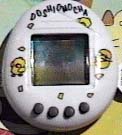 |
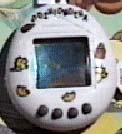 |
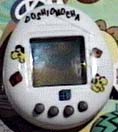 |
My Chick |
My Dino |
My Dog |
 |
 |
Tamagotchi |
Tamagochan |
As the original pets were being "cloned", manufacturers also added many new animals as pets. Bats, Fish, Frogs, Lizards, Pandas, Parrots, Penguins, and Turtles to name a few.
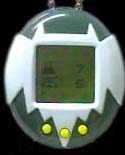 |
 |
My Baby |
Yuki Penguin / |
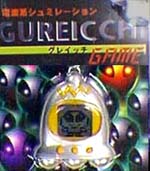 |
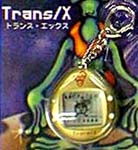 |
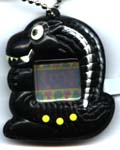 |
Gurreicchi |
TransX |
gyao-ppi |
While the pets were making there rounds at being various animals, human pets began to appear. First they were simple baby pets, then girl pets and boy pets. Additional pets representing people were Nano Baby, Venus, My Beauty Baby, Baby Byte, Rikou Rikou Chan, and My Baby.
 |
 |
My Beauty |
RikouRikou |
 |
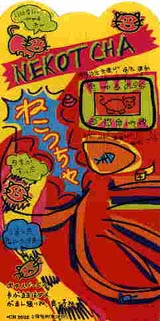 |
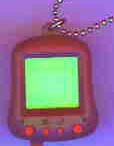 |
 |
New pets have many more activities and possible life paths than the early pets. Several of the pets can be "named" by selecting letters one at a time. They play more exciting games with you (tag, guessing game, shaking hands, fetch, reading, "rocks, scissors, paper" and many others). Several pets change into different characters and roles in response to how you care for them. These changes make them more interesting than the early pets.
Many manufacturers reply to their pets as "the latest generation virtual pet". Others refer to their pets as 2nd generation virtual pets. We even saw one labeled the 4th generation virtual pet. This is done to indicate the units are newer and more complex than the early units.
Most new pets have 5 buttons. Four on the front for mode/select, enter, left, and right plus one (often on the back) for reset. Some pets have additional buttons for other functions such as muting the sound..
 |
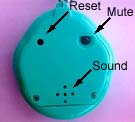 |
Rikou Rikou |
Back of |
As the pets became more complex and more features were added, the viewing screens have been made larger. "Line" or "segmented" (LCD) displays are used by some pets. These displays have sharper images but are limited in their ability to display animation. My Beauty Baby was one of the first to have both increased viewing area and an LCD "line" display. Dot Matrix (pixel) displays offer better animation and are more customizable.
 |
 |
My Beauty |
A Bandai |

Return to Virtual Pet Home Page